Abstract
Femur intertrochanteric and subtrochanteric fractures are extracapsular hip fractures and they show a bimodal age distribution. Most hip fractures in young patient are subtrochanteric or basicervical fractures that are caused by high energy injury. Most of the hip fractures in old patients are intertrochanteric fractures related to osteoporosis and low energy injury. For proximal hip fractures, the muscles around the hip joint make reduction difficult and the position of the lag screws affects healing of the fracture. To lower the complications of these fractures, surgeons can use an appropriate implant along with performing good reduction and good lag screw positioning. We report here on our review of femur intertrochanteric and subtrochanteric fractures, the characteristics of compression hip screws, the intramedullary devices and the technical pitfalls.
Figures and Tables
References
1. Koval KJ, Aharonoff GB, Rokito AS, Lyon T, Zuckerman JD. Patients with femoral neck and intertrochanteric fractures: Are they same? Clin Orthop Relat Res. 1996. 330:166–172.
2. Lorich DG, Geller DS, Nielson JH. Osteoporotic pertrochanteric hip fractures: management and current controversies. Instr Course Lect. 2004. 53:441–454.
3. Koval KJ, Cantu RV. Rockwood CA, Green DP, editors. Intertrochanteric fractures. Fracture in adults. 2004. 5th ed. Philadelphia: JB Lippincott;1793–1825.

4. La Velle DG. Crenshaw AH, editor. Fractures of hip. Campbell's operative orthopaedics. 2008. 11th ed. Philadelphia: Mosby Inc;3237–3285.
5. Lee SH. Treatment of intertrochanteric fracture of the femur. J Korean Hip Soc. 2005. 17:206–210.
6. Templeman D, Baumgaertner MR, Leighton RK, Lindsey RW, Moed BR. Reducing complications in the surgical treatment of intertrochanteric fractures. Instr Course Lect. 2005. 54:409–415.
7. Yang KH. Treatment of pertrochanteric fractures. J Korean Fract Soc. 2005. 18:76–82.
8. Evans EM. Trochanteric fractures; a review of 110 cases treated by nail-plate fixation. J Bone Joint Surg Br. 1951. 33:192–204.
9. Rha JD, Kim YH, Yoon SI, Park TS, Lee MH. Factors affecting sliding of the lag screw in intertrochanteric fractures. Int Orthop. 1993. 17:320–324.

10. Baumgaertner MR, Curtin SL, Lindskog DM, Keggi JM. The value of tip-apex distance in predicting failure of fixation of peritrochanteric fractures of the hip. J Bone Joint Surg Am. 1995. 77:1058–1064.

11. Davis TR, Sher JL, Horsman A, Simpson M, Porter BB, Checjetts RG. Intertrochanteric femoral fractures. mechanical failure after internal fixation. J Bone Joint Surg Br. 1990. 72:26–31.

13. Ahrengart L, Törnkvist H, Fornander P, et al. A randomized study of the compression hip screw and gamma nail in 426 fractures. Clin Orthop Relat Res. 2002. 401:209–222.

14. Kyle RF, Cabanela ME, Russel TA, et al. Fractures of the proximal part of the femur. Instr Course Lect. 1995. 44:227–253.

15. Babst R, Renner N, Biedermann M, et al. Clinical results using the trochanter stabilizing plate (TSP): the modular extension of the dynamic hip screw (DHS) for internal fixation of selected unstable intertrochanteric fractures. J Orthop Trauma. 1998. 12:392–399.

16. Bong MR, Patel V, Iesaka K, Egol KA, Kummer FJ, Koval KJ. Comparison of sliding hip screw with a trochanteric lateral support plate to an intramedullary hip screw for fixation of unstable intertrochanteric hip fractures: a cadaver study. J Trauma. 2004. 56:791–794.

17. Seong YB, Sohn YJ, Yum JG, et al. Intertrochanteric fracture of the femur treated with proximal femoral nail: long term results. J Korean Hip Soc. 2005. 17:141–148.
18. Hwang DS, Kwak SK, Woo SM. Results of cementless hemiarthroplasty for elderly patients with unstable intertrochanteric fractures. J Korean Hip Soc. 2004. 16:386–391.
19. Kim JH, Lee S, Jeong SY, Park JS, Seo YH. Bipolar hemiarthroplasty using the greater trochanter reattachment device (GTRD) for comminuted intertrochanteric fracture in elderly patients. J Korean Hip Soc. 2004. 16:441–446.
20. Goldhagen PR, O'Connor DR, Schwarze D, Schwartz E. A prospective comparative study of the compression hip screw and the gamma nail. J Orthop Trauma. 1994. 8:367–372.

21. Zuckerman JD. Comprehensive care of orthopedic injuries in elderly. 1990. Baltimore: Urbanand & Schwarzenberg.
22. Soballe K. Laceration of superficial femoral artery by an intertrochanteric fracture fragment. J Bone Joint Surg Am. 1987. 69:781–783.
23. Koval KJ, Skovron ML, Aharonoff GB, Zuckerman JD. Predictors of functional recovery after hip fractures in the elderly. Clin Orthop Relat Res. 1998. 348:22–28.
24. Baumgaertner MR, Chrostowski JH, Levy RN. Bowner BD, Levine AM, Jupiter JB, Trafton PG, editors. Intertrochanteric hip fracture. Skeletal trauma. 1992. vol 2. Philadelphia: WB Saunders;1833–1881.
25. Cheng CL, Chow SP, Pun WK, Leong JC. Long-term results and complications of cement augmentation in the treatment of unstable trochanteric fractures. Injury. 1989. 20:134–138.

26. Harrington KD. The use of methylmethacrylate as an adjunct in the internal fixation of unstable comminuted intertrochanteric fractures in osteoporotic patients. J Bone Joint Surg Am. 1975. 57:744–750.

27. Moroni A, Faldini C, Pegreffi F, et al. How to prevent fixation failure in patients with an osteoporotic trochanteric fractures treated with dynamic hip screw: a prospective randomized study. 2002. In : Annual OTA meeting;
30. Russell TA, Taylor JC. Browner BD, Jupiter JB, Levine AM, editors. Subtrochanteric fractures of the femur. Skeletal Trauma. 1992. Philadelphia: WB Saunders Co;1485–1524.




 PDF
PDF ePub
ePub Citation
Citation Print
Print




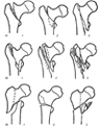
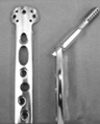

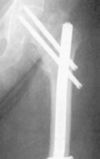
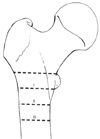
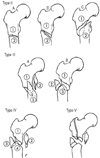
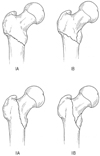

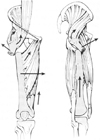


 XML Download
XML Download